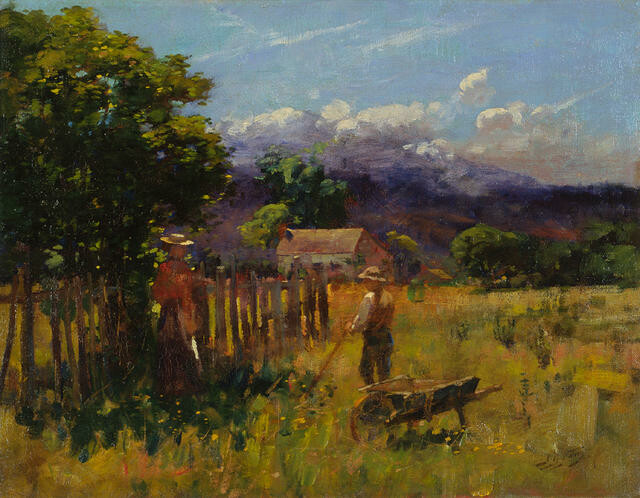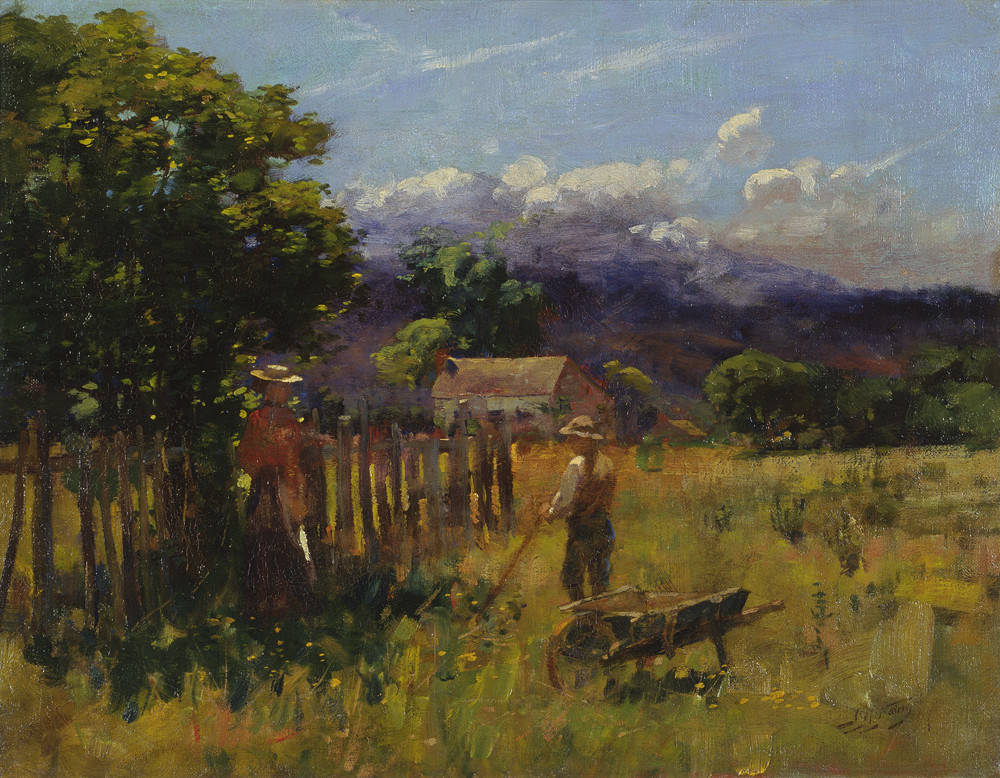James McLachlan Nairn
Aotearoa New Zealand / Scotland, b.1859, d.1904
A Summer Idyll
- 1897
- Oil on canvas
- Presented by the Canterbury Society of Arts, 1932
- 455 x 560 x 55mm
- 69/500
Tags: buildings (structures), carts, clouds, cottages, farms, fences, hats, landscapes (representations), mountains, people (agents), sunlight, trees
This luminous pastoral scene was painted at Silverstream; in the Hutt Valley within easy reach from Wellington. It was here that Nairn and other artists rented Pumpkin Cottage, which can be seen in the background. The artists enjoyed travelling from Wellington to paint the countryside outdoors, or plein-air, and develop their interests in impressionism. Nairn, who had trained and worked as a professional artist in Scotland, was very much the group’s leader and was instrumental in establishing the Wellington Art Club in 1892 as an alternative to the more conservative New Zealand Academy of Fine Arts. (March 2018)
This simple rural scene was painted in the Hutt Valley near Wellington, but James Nairn’s subject is really the study of light, atmosphere and colour. The figures are just features of the landscape, like the grasses, large tree or distant cottage. Trained in Scotland and a member of the Glasgow School of artists, Nairn used a modified form of French Impressionism, more subdued in colour and with more regulated brush strokes, but which still sought to capture the immediacy of outdoor light and particularly the effect of strong sunlight on outdoor forms. Nairn had a very significant impact on New Zealand painting. He was born in Aberfoyle, near Glasgow, and studied at the Glasgow Institute of Fine Arts and at the Académie Julian, Paris. He emigrated to New Zealand in 1890 and was appointed teacher at the Wellington School of Design (Wellington Technical College). Dissatisfied with the New Zealand Academy of Fine Arts, Nairn formed the Wellington Art Club, but he later rejoined the Academy and exhibited with them. (Label date unknown)
Prior to coming to New Zealand in 1890, Scottish born artist James Nairn the painter of this work had trained at Glasgow School of Art and had worked with a group of painters popularly known as ‘The Glasgow Boys’.
This group was strongly influenced by developments in French painting during the 1870s and 1880s, in particular Impressionism. Many like Nairn had also studied in Paris and worked ‘plein-air’ out of doors directly from nature. This painting reveals a little of Nairn's concern with plein-air realism. Such outdoor scenes concerned with work more strongly paralleled those of Millet, particularly Bastien Lepage, than the tenets of French Impressionism.
The location of this particular subject is the Hutt Valley near Wellington which in the 1890s was still very rural and sparsely populated. It was a favourite place for Nairn and fellow artists to explore the effects of light and colour on the landscape.
He established a weekend retreat there which became known as ‘Pumpkin Cottage’. Nairn's concern for colour did much to invigorate painting in Wellington during the 1890s and early 1900s.
(Label date unknown)

